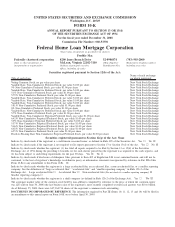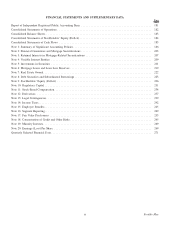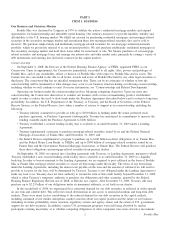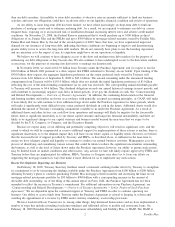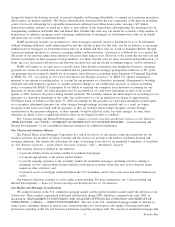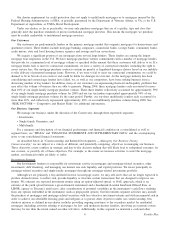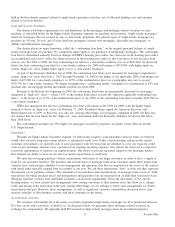Freddie Mac 2008 Annual Report Download - page 10
Download and view the complete annual report
Please find page 10 of the 2008 Freddie Mac annual report below. You can navigate through the pages in the report by either clicking on the pages listed below, or by using the keyword search tool below to find specific information within the annual report.
investments portfolio, comprised primarily of cash and cash equivalents, non-mortgage-related securities, federal funds sold
and securities purchased under agreements to resell, to help manage our liquidity needs.
Debt Financing
We fund our investment activities in our Investments and Multifamily segments by issuing short-term and long-term
debt. Competition for funding in the capital markets can vary with economic and financial market conditions and regulatory
environments. For example, under the recent Federal Deposit Insurance Corporation, or FDIC, temporary liquidity guarantee
program, participating banks and holding companies may issue senior, short-term unsecured debt that is guaranteed by the
U.S. government, which improves their ability to compete with us for debt funding. In the second half of 2008, we
experienced less demand for our debt securities, as reflected in wider spreads on our term and callable debt. This reflected
overall deterioration in our access to unsecured medium and long-term debt markets to fund our purchases of mortgage
assets and to refinance maturing debt. As a result, we have been required to refinance our debt on a more frequent basis,
exposing us to an increased risk of insufficient demand and adverse credit market conditions. However, the Federal Reserve
has been an active purchaser in the secondary market of our long-term debt under its purchase program as discussed below,
and spreads on our debt and our access to the debt markets have improved in early 2009 as a result of this activity.
Subsequent to our entry into conservatorship, Treasury and the Federal Reserve took certain actions affecting our access
to debt financing, including the following:
• on September 18, 2008, we entered into the Lending Agreement with Treasury, pursuant to which Treasury
established a secured lending credit facility that is available to us until December 31, 2009 as a liquidity backstop
(after December 31, 2009, Treasury still may purchase up to $2.25 billion of our obligations under its permanent
authority, as set forth in our charter); and
• on November 25, 2008, the Federal Reserve announced a program to purchase up to $100 billion in direct obligations
of Freddie Mac, Fannie Mae and the FHLBs.
The support of the Federal Reserve has helped to improve spreads on our debt and our access to the debt markets.
For more information, see “Conservatorship and Related Developments” and “MD&A — LIQUIDITY AND CAPITAL
RESOURCES.”
Risk Management
Our Investments segment has responsibility for managing our interest rate and liquidity risks. We use derivatives to:
(a) regularly adjust or rebalance our funding mix in order to more closely match changes in the interest rate characteristics of
our mortgage-related assets; (b) economically hedge forecasted issuances of debt and synthetically create callable and non-
callable funding; and (c) economically hedge foreign-currency exposure. For more information regarding our derivatives, see
“QUANTITATIVE AND QUALITATIVE DISCLOSURES ABOUT MARKET RISK” and “NOTE 12: DERIVATIVES” to
our consolidated financial statements.
PC and Structured Securities Support Activities
We support the liquidity of the market for PCs through a variety of activities, including educating dealers and investors
about the merits of trading and investing in PCs, enhancing disclosure related to the collateral underlying our securities and
introducing new mortgage-related securities products and initiatives. We support the price performance of our PCs through a
variety of strategies, including the purchase and sale of PCs and other agency securities, as well as through the issuance of
Structured Securities. Agency securities refer to securities issued by Freddie Mac, Fannie Mae, a similarly chartered
government-sponsored enterprise, or GSE, and Ginnie Mae. As discussed in “Single-Family Guarantee Segment,” our
Structured Securities represent beneficial interests in pools of PCs and certain other types of mortgage-related assets. Our
purchases and sales of mortgage securities influence the relative supply and demand for these securities, and the issuance of
Structured Securities increases demand for our PCs. Increasing demand for our PCs helps support the price performance of
our PCs. This in turn helps our competitiveness in purchasing mortgages from our lender customers. Depending upon market
conditions, including the relative prices, supply of and demand for PCs and comparable Fannie Mae securities, as well as
other factors, there may be substantial variability in any period in the total amount of securities we purchase or sell. We may
increase, reduce or discontinue these or other related activities at any time, which could affect the liquidity of the market for
PCs.
Single-Family Guarantee Segment
In our Single-family Guarantee segment, we purchase single-family mortgages originated by our lender customers in the
primary mortgage market, primarily through our guarantor swap program. We securitize mortgages we have purchased and
issue mortgage-related securities that can be sold to investors or held by us in our Investments segment. Earnings for this
segment consist primarily of management and guarantee fee revenues, including amortization of upfront payments we
receive, less related credit costs and operating expenses. Earnings for this segment also include the interest earned on assets
7Freddie Mac

